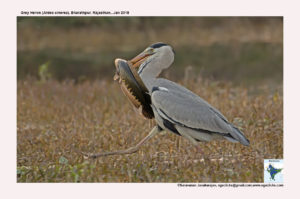Grey Heron

Grey Heron Ardea cinerea
Etymology:
- Ardea : Latin word ardea- In Roman mythology the town of Ardea, capital of the Rutuli, was razed to theground, and from the ashes rose a lean, pale bird,shaking the cinders from its wings and utteringmournful cries.
- Cinerea : Latin word cinis, cineris – ashes { Ashy grey}
Vernacular Names: Sind: Saa, Hindi: Nari, Sain, Kabud, Anjan, Sans: Parssik anjan bak, Kash: Brag, Pun: Nari, Bi: Khyra, Ass: Ajan, Halkheda, Ben: Sada kank, Kank, Anjan, Guj: Kabut, Kabooth bagala, Mar: Kudal (Kolis), Rakhi bagla, Ori: Kuji baga, Ta: Sambal naarai, Te: Narayana pakshi, Mal: Charamunti, Kan: Boodu baka, Sinh: Kalapua karawal koka, Indura koka
Distribution in India: Wide spread resident except for Himalayas, winter visitor to central India, Western Ghats and North West India.
Description:Size of 90–98 cm; wt. of 1020–2073 g; wingspan of 175–195 cm. The forehead, crown and throat are white, with broad black eyestripe from above eye to back of crown and extending as crest plumes that is fully developed only during breeding season. It has a greyish-white foreneck with two distinct broken black streaks along median line, pale grey upper back and hindneck, blue-grey lower back and upperwings, dark grey to black flight feathers, grey to whitish underwing, black shoulder patch, grey flanks and tail, black belly-sides and pale grey to white over rest of underparts. It has a long, heavy yellow bill with dull brown suffusion, yellow eyes and lores, and brownish-yellow legs and feet, all of which is flushed to deep orange to red during breeding season. The male averages larger than female. The non-breeding adult lacks long plumes of breast and scapulars. The juvenile plumage is retained until second year , it is more uniform grey, with brown-grey foreneck, grey underparts, duller bare parts ,dark grey legs, becoming paler and tinge yellow-green on upper tibia, and no ornamental plumes.
Habitat:It is found in any kind of shallow water, fresh, brackish or salt, standing or flowing. It prefers areas with some trees. It is from sea level up to 4000 m.
Food Habits: It stand still at the water’s edge and wait to ambush prey, mainly at night or early morning. It primarily eats small fish, crustaceans, frogs, aquatic insects, small mammals, and small birds. During the day it rests in trees or bushes.
Breeding Habits: They breed in colonies known as heronries. Breeding activities take place between February and June. When a bird arrives at the nest, a greeting ceremony occurs in which each partner raises and lowers its wings and plumes. Courtship involves the male calling from the chosen nesting site. On the arrival of the female, both birds participate in a stretching ceremony, in which each bird extends its neck vertically before bringing it backwards and downwards with the bill remaining vertical, simultaneously flexing its legs, before returning to its normal stance. The snapping ceremony is another behaviour where the neck is extended forward, the head is lowered to the level of the feet and the mandibles are vigorously snapped together. This may be repeated twenty to forty times. When the pairing is settled, the birds may caress each other by attending to the other bird’s plumage. The male then offers the female a stick which she incorporates into the nest. At this, the male becomes excited, further preening the female and copulation takes place. Usually the nest is built on high trees close to lakes, the seashore or other wetlands, low trees and bushes, bramble patches, reed beds, heather clumps and cliff ledges. The same nest is used year after year until blown down; it starts as a small platform of sticks but expands into a bulky nest as more material is added in subsequent years. It may be lined with smaller twigs, strands of root or dead grasses, and in reed beds, it is built from dead reeds. The male usually collects the material while the female constructs the nest. The clutch is of 3-5 eggs.The eggs are normally laid at two-day intervals and incubation usually starts after the first or second egg has been laid. Both birds take part in incubation and the period lasts for about 25 days. Both parents bring food for the young. At first the chicks seize the adult’s bill from the side and extract regurgitated food from it. Later the adult disgorges the food at the nest and the chicks squabble for possession. They fledge at seven to eight weeks.